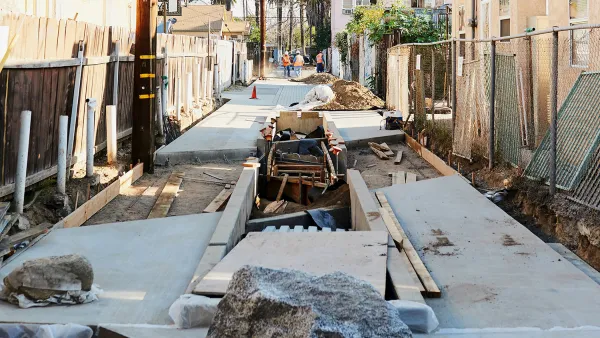The state of California, along with county and city officials, have taken several steps forward on plans and projects that could help Los Angeles wean itself from imported water.
Monte Morin reported in mid-June that the California State Water Resources Control Board adopted new rules "aimed at capturing and reusing huge amounts of stormwater that have until now flowed down sewers and concrete rivers into the sea." The rules apply to Los Angeles County, but they're being pitched as "a model for other parts of water-starved California."
In effect, the rule change allows "a controversial set of revisions to Los Angeles County's stormwater discharge permit."
"Among other things, the revisions provide a framework for cities to plan and build aquifer recharge systems and other forms of "green infrastructure," according to Morin.
Later in the month, the Los Angeles Department of Water and Power (LADWP), a city agency, announced its Stormwater Capture Master Plan—"an initiative that officials say will reduce the city's future reliance on imported water and perhaps address a predicted trend toward heavier, more intense rainfall."
Morin summarizes more of the LADWP master plan:
"The plan includes three large-scale projects in the San Fernando Valley that would collect rainfall in basins or washes and then slowly feed it into the city's primary underground water source — a process known as aquifer recharge.
The proposal also lists a variety of smaller features that would be located on public, private and commercial properties throughout the city: Water-permeable surfaces that would help recharge the San Fernando Valley groundwater basin, as well as redesigned 'green streets' and pocket parks."
FULL STORY: L.A. County's plan to capture stormwater could be state model

National Parks Layoffs Will Cause Communities to Lose Billions
Thousands of essential park workers were laid off this week, just before the busy spring break season.

Retro-silient?: America’s First “Eco-burb,” The Woodlands Turns 50
A master-planned community north of Houston offers lessons on green infrastructure and resilient design, but falls short of its founder’s lofty affordability and walkability goals.

Delivering for America Plan Will Downgrade Mail Service in at Least 49.5 Percent of Zip Codes
Republican and Democrat lawmakers criticize the plan for its disproportionate negative impact on rural communities.

Test News Post 1
This is a summary

Test News Headline 46
Test for the image on the front page.

Balancing Bombs and Butterflies: How the National Guard Protects a Rare Species
The National Guard at Fort Indiantown Gap uses GIS technology and land management strategies to balance military training with conservation efforts, ensuring the survival of the rare eastern regal fritillary butterfly.
Urban Design for Planners 1: Software Tools
This six-course series explores essential urban design concepts using open source software and equips planners with the tools they need to participate fully in the urban design process.
Planning for Universal Design
Learn the tools for implementing Universal Design in planning regulations.
EMC Planning Group, Inc.
Planetizen
Planetizen
Mpact (formerly Rail~Volution)
Great Falls Development Authority, Inc.
HUDs Office of Policy Development and Research
NYU Wagner Graduate School of Public Service




























